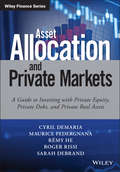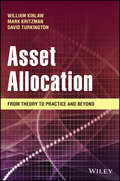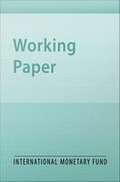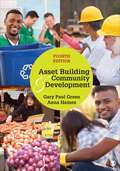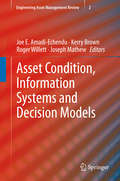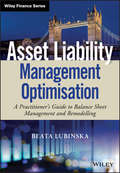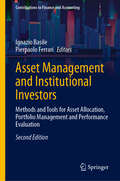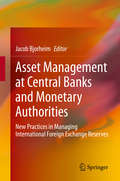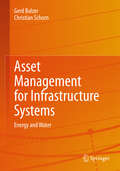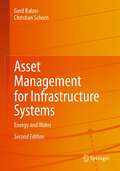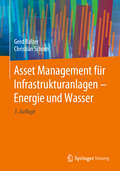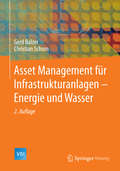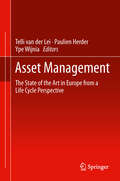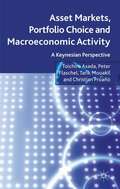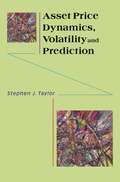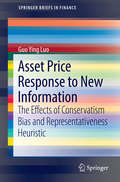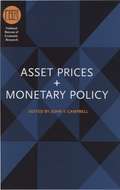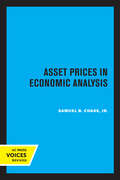- Table View
- List View
Asset Allocation and Private Markets: A Guide to Investing with Private Equity, Private Debt, and Private Real Assets (Wiley Finance)
by Cyril Demaria Roger Rissi Maurice Pedergnana Remy He Sarah DebrandThe comprehensive guide to private market asset allocation Asset Allocation and Private Markets provides institutional investors, such as pension funds, insurance groups and family offices, with a single-volume authoritative resource on including private markets in strategic asset allocation. Written by four academic and practitioner specialists, this book provides the background knowledge investors need, coupled with practical advice from experts in the field. The discussion focuses on private equity, private debt and private real assets, and their correlation with other asset classes to establish optimized investment portfolios. Armed with the grounded and critical perspectives provided in this book, investors can tailor their portfolio and effectively allocate assets to traditional and private markets in their best interest. In-depth discussion of return, risks, liquidity and other factors of asset allocation takes a more practical turn with guidance on allocation construction and capital deployment, the “endowment model,” and hedging — or lack thereof. Unique in the depth and breadth of information on this increasingly attractive asset class, this book is an invaluable resource for investors seeking new strategies. Discover alternative solutions to traditional asset allocation strategies Consider attractive returns of private markets Delve into private equity, private debt and private real assets Gain expert perspectives on correlation, risk, liquidity, and portfolio construction Private markets represent a substantial proportion of global wealth. Amidst disappointing returns from stocks and bonds, investors are increasingly looking to revitalise traditional asset allocation strategies by weighting private market structures more heavily in their portfolios. Pension fund and other long-term asset managers need deeper information than is typically provided in tangential reference in broader asset allocation literature; Asset Allocation and Private Markets fills the gap, with comprehensive information and practical guidance.
Asset Allocation at the Cook County Pension Fund
by Juliane Begenau Emil Nuwan Siriwardane Yuval GonczarowskiNickol Hackett, chief investment officer of the Cook County Pension Fund, is responsible for investing the fund's $9 billion worth of assets on behalf of the employees of Cook County, Illinois. Like many other defined-benefit pensions at the time, the Cook County pension faces a funding shortfall, meaning that the value of its assets is below the value of its future obligations to retirees. Hackett can invest in fixed income securities, public equities, and alternative assets such as hedge funds, real estate, or private equity. What are the costs and benefits of each asset class? Should the funding status of the pension impact the asset allocation process? How should Hackett invest in order to grow the value of the fund's assets and secure the retirement benefits for thousands of Cook County's employees?
Asset Allocation: From Theory to Practice and Beyond (Wiley Finance Ser.)
by Mark P. Kritzman David Turkington William KinlawDiscover a masterful exploration of the fallacies and challenges of asset allocation In Asset Allocation: From Theory to Practice and Beyond—the newly and substantially revised Second Edition of A Practitioner’s Guide to Asset Allocation—accomplished finance professionals William Kinlaw, Mark P. Kritzman, and David Turkington deliver a robust and insightful exploration of the core tenets of asset allocation. Drawing on their experience working with hundreds of the world’s largest and most sophisticated investors, the authors review foundational concepts, debunk fallacies, and address cutting-edge themes like factor investing and scenario analysis. The new edition also includes references to related topics at the end of each chapter and a summary of key takeaways to help readers rapidly locate material of interest. The book also incorporates discussions of: The characteristics that define an asset class, including stability, investability, and similarity The fundamentals of asset allocation, including definitions of expected return, portfolio risk, and diversification Advanced topics like factor investing, asymmetric diversification, fat tails, long-term investing, and enhanced scenario analysis as well as tools to address challenges such as liquidity, rebalancing, constraints, and within-horizon risk. Perfect for client-facing practitioners as well as scholars who seek to understand practical techniques, Asset Allocation: From Theory to Practice and Beyond is a must-read resource from an author team of distinguished finance experts and a forward by Nobel prize winner Harry Markowitz.
Asset Booms and Structural Fiscal Positions: The Case of Ireland
by Daniel KandaA report from the International Monetary Fund.
Asset Building & Community Development
by Gary Paul Green Anna L. HainesA comprehensive approach focused on sustainable change Asset Building and Community Development, Fourth Edition examines the promise and limits of community development by showing students and practitioners how asset-based developments can improve the sustainability and quality of life. Authors Gary Paul Green and Anna Haines provide an engaging, thought-provoking, and comprehensive approach to asset building by focusing on the role of different forms of community capital in the development process. Updated throughout, this edition explores how communities are building on their key assets—physical, human, social, financial, environmental, political, and cultural capital— to generate positive change. With a focus on community outcomes, the authors illustrate how development controlled by community-based organizations provides a better match between assets and the needs of the community.
Asset Building & Community Development
by Gary Paul Green Anna L. HainesA comprehensive approach focused on sustainable change Asset Building and Community Development, Fourth Edition examines the promise and limits of community development by showing students and practitioners how asset-based developments can improve the sustainability and quality of life. Authors Gary Paul Green and Anna Haines provide an engaging, thought-provoking, and comprehensive approach to asset building by focusing on the role of different forms of community capital in the development process. Updated throughout, this edition explores how communities are building on their key assets—physical, human, social, financial, environmental, political, and cultural capital— to generate positive change. With a focus on community outcomes, the authors illustrate how development controlled by community-based organizations provides a better match between assets and the needs of the community.
Asset Building Community Development Fourth Edition
by Gary Paul Green Anna HainesAsset Building and Community Development, Fourth Edition examines the promise and limits of community development by showing students and practitioners how asset-based developments can improve the sustainability and quality of life. Authors Gary Paul Green and Anna Haines provide an engaging, thought-provoking, and comprehensive approach to asset building by focusing on the role of different forms of community capital in the development process. Updated throughout, this edition explores how communities are building on their key assets—physical, human, social, financial, environmental, political, and cultural capital— to generate positive change. With a focus on community outcomes, the authors illustrate how development controlled by community-based organizations provides a better match between assets and the needs of the community.
Asset Condition, Information Systems and Decision Models: Engineering Asset Management Review Vol. 2 (Engineering Asset Management Review #2)
by Joseph Mathew Roger Willett Joe E. Amadi-Echendu Kerry BrownAsset Condition, Information Systems and Decision Models, is the second volume of the Engineering Asset Management Review Series. The manuscripts provide examples of implementations of asset information systems as well as some practical applications of condition data for diagnostics and prognostics. The increasing trend is towards prognostics rather than diagnostics, hence the need for assessment and decision models that promote the conversion of condition data into prognostic information to improve life-cycle planning for engineered assets. The research papers included here serve to support the on-going development of Condition Monitoring standards. This volume comprises selected papers from the 1st, 2nd, and 3rd World Congresses on Engineering Asset Management, which were convened under the auspices of ISEAM in collaboration with a number of organisations, including CIEAM Australia, Asset Management Council Australia, BINDT UK, and Chinese Academy of Sciences, Beijing University of Chemical Technology, China. Asset Condition, Information Systems and Decision Models will be of particular interest to finance, maintenance, and operations personnel whose roles directly affect the capability value of engineering asset base, as well as asset managers in both industry and government.
Asset Intelligence through Integration and Interoperability and Contemporary Vibration Engineering Technologies: Proceedings of the 12th World Congress on Engineering Asset Management and the 13th International Conference on Vibration Engineering and Technology of Machinery (Lecture Notes in Mechanical Engineering)
by Lin Ma Joseph Mathew C. W. Lim Don Sands Michael E. Cholette Pietro BorghesaniThese proceedings include a collection of papers on a range of topics presented at the 12th World Congress on Engineering Asset Management (WCEAM) in Brisbane, 2 – 4 August 2017. Effective strategies are required for managing complex engineering assets such as built environments, infrastructure, plants, equipment, hardware systems and components. Following the release of the ISO 5500x set of standards in 2014, the 12th WCEAM addressed important issues covering all aspects of engineering asset management across various sectors including health. The topics discussed by the congress delegates are grouped into a number of tracks, including strategies for investment and divestment of assets, operations and maintenance of assets, assessment of assets’ health conditions, risk and vulnerability, technologies, and systems for management of assets, standards, education, training and certification.
Asset Liability Management Optimisation: A Practitioner's Guide to Balance Sheet Management and Remodelling (Wiley Finance)
by Beata LubinskaAn advanced method for financial institutions to optimize Asset Liability Management for maximized return and minimized risk Financial institutions today are facing daunting regulatory and economic challenges. As they manage bank regulation and competition, institutions are also optimizing their Asset Liability Management (ALM) operations. The function of the ALM unit today goes beyond risk management related to the banking book into managing regulatory capital and positioning the balance sheet to maximize profit. Asset Liability Management Optimization: A Practitioner's Guide to Balance Sheet Management and Remodelling offers a step-by-step process for modeling and reshaping a bank's balance sheet. Based on the author's extensive research, it describes how to apply a quantifiable optimization method to help maximize asset return and minimize funding cost in the banking book. ALM ranks as a key component of any financial institution's overall operating strategy. Now, financial professionals can use an advanced solution for optimizing ALM. This book takes a closer look at the evolving role of the ALM function and the target position of the banking book. It provides strategies for active management, structuring, and hedging of a bank balance sheet, while also exploring additional topics related to ALM. A description of the Funds Transfer Pricing (FTP) process related to a bank’s target position Detailed examinations of interest rate risk in the banking book (IRRBB) Discussion of Basel III regulatory requirements and maturity gap analysis Overview of customer behavior, along with its impact on interest rate and liquidity risk Practical spreadsheet models (NII sensitivity and EVE volatility IRRBB model, simplified optimization model for minimization of average funding cost for a bank and an example of behavioral model for Non-Maturing Deposits) Explorations of model risk, sensitivity analysis, and case studies The optimization techniques found in Asset Liability Management Optimization can prove vital to financial professionals who are tasked with maximizing asset return and reducing funding costs as a critical part of business objectives.
Asset Maintenance Management in Industry: A Comprehensive Guide to Strategies, Practices and Benchmarking (International Series in Operations Research & Management Science #310)
by Rama Srinivasan Velmurugan Tarun DhingraThis book introduces readers to essential strategies, practices, and benchmarking for asset maintenance in operations intensive industries. Drawing on a case study from the oil and gas sector, it offers a methodology and practical solutions to help maintenance practitioners select and formulate an asset maintenance strategy, and to establish best maintenance practices at an organizational level using the frameworks developed here. It is intended for industry practitioners, young maintenance professionals, and students of engineering management who aspire to a career in operations intensive industries.
Asset Management Decision-Making For Infrastructure Systems
by Alireza Mohammadi Luis Amador JimenezThis textbook provides practical and concrete guidance for the step-by-step implementation of decision-making for infrastructure asset management. Examples are used to illustrate how data from condition assessment are used to develop performance models, to estimate the effectiveness of investments that are prioritized and scheduled to accomplish reliable and convenient infrastructure for the wellbeing of the public and regional economic competitiveness. Book illustrates numerous worked problems to clarify ambiguity in developing a decision-making platform to prioritize assets and distribute budgets effectively and efficiently.Ensures reader understanding of the benefits and challenges of infrastructure asset management; Provides a step-by-step guide for the development of each component of an asset management decision-making system;Includes worked examples to clarify decision-making and budget allocation process.
Asset Management and Institutional Investors
by Pierpaolo Ferrari Ignazio BasileThis book analyses investment management policies for institutional investors. It is composed of four parts. The first one analyses the various types of institutional investors, institutions which, with different objectives, professionally manage portfolios of financial and real assets on behalf of a wide variety of individuals. This part goes on with an in-depth analysis of the economic, technical and regulatory characteristics of the different types of investment funds and of other types of asset management products, which have a high rate of substitutability with investment funds and represent their natural competitors. The second part of the book identifies and investigates the stages of the investment portfolio management. Given the importance of strategic asset allocation in explaining the ex post performance of any type of investment portfolio, this part provides an in-depth analysis of asset allocation methods, illustrating the different theoretical and operational solutions available to institutional investors. The third part describes performance assessment, its breakdown and risk control, with an in-depth examination of performance evaluation techniques, returns-based style analysis approaches, and performance attribution models. Finally, the fourth part deals with the subject of diversification into alternative asset classes, identifying the common characteristics and their possible role within the framework of investment management policies. This part analyses hedge funds, private equity, real estate, commodities, and currency overlay techniques.
Asset Management and Institutional Investors: Methods and Tools for Asset Allocation, Portfolio Management and Performance Evaluation (Contributions to Finance and Accounting)
by Pierpaolo Ferrari Ignazio BasileThis second edition of the book analyses the latest developments in investment management policy for institutional investors. It is divided into four parts, which have been updated to include the newest approaches and strategies in asset allocation, portfolio management and performance evaluation. The first part analyses the different types of institutional investors, i.e. institutions that professionally manage portfolios of financial and real assets on behalf of a wide range of individuals. This part goes on with an in-depth analysis of the economic, technical and regulatory characteristics of the various categories of investment funds and of other types of asset management products, which have a high rate of substitutability with investment funds and represent their natural competitors. The second part of the book identifies and investigates the stages of the investment portfolio management. Given the importance of strategic asset allocation in explaining the ex post performance of any type of investment portfolio, this part provides an in-depth analysis of asset allocation methods, illustrating the different theoretical and operational solutions available to institutional investors. The third part describes performance assessment, its breakdown and risk control, with an in-depth examination of performance evaluation techniques, returns-based style analysis approaches and performance attribution models. Finally, the fourth part deals with the subject of diversification into alternative asset classes, identifying the common characteristics and their possible role within the framework of investment management policy. This part analyses hedge funds, private equity, private debt, real estate, infrastructures, commodities and currency overlay techniques.
Asset Management at Central Banks and Monetary Authorities: New Practices in Managing International Foreign Exchange Reserves
by Jacob BjorheimIn response to the Global Financial Crisis and the COVID-19 pandemic, central banks have used all available instruments in their monetary policy tool-kit to avoid financial market disruptions and a collapse in real economic activities. These actions have expanded the size of their balance sheets and altered the composition of the asset-side. This edited book highlights how these assets are managed, providing an intellectual and practical contribution to an under-researched field of central bank responsibilities. It first reviews the sources and uses of domestic and international assets and how they complement—or possibly conflict with—the implementation of monetary policy goals. Next, the book examines the asset management mandate in a balance sheet context before turning to the investment decision-making process from strategic and tactical asset allocation to investment strategies, risk management, governance, reporting and control. Finally, it presents new developments in the field of managing assets at central banks. The individual chapters are written by central bankers, academics, and representatives from International Financial Institutions, each representing a particular aspect of the asset management practice.Practical and powerful insights from a hall of fame of investors, central bankers and scholars, are packed into this one volume. If you could have only one book on central bank asset management, this would be it. —Peter R. Fisher, Clinical Professor, Tuck School of Business at DartmouthJacob Bjorheim draws on his long experience in sovereign asset management to pull together a rich collection of insights from a broad range of expertise. Asset management at central banks has evolved and expanded considerably over the past decade. This book is a timely source of information and guidance. —Guy Debelle, Deputy Governor, Reserve Bank of AustraliaCentral bank balance sheets have grown at a tremendous pace over the last decade and a half. Drawing on contributions from scholars and experienced central bankers from around the world, this timely and insightful book sheds light on how central banks are, and should be, managing their growing balance sheets. —Kjell G. Nyborg, Chaired Professor of Finance, University of Zurich, Author of Collateral Frameworks: The Open Secret of Central BanksCentral banks and monetary authorities are charged with, and being held accountable for, managing portfolios of foreign currency assets of unprecedented size. The essays in this admirable book, written by some of the worlds most highly experienced officials, cover the full range of why and how this is currently being done and how new developments are affecting old practices. Interesting conceptually and immensely useful practically. —William White, Senior Fellow at the C.D. Howe Institute, former Head of the Monetary and Economic Department with the Bank for International Settlements (BIS) and chairman of the Economic and Development Review Committee at the OECDAn excellent and timely review of modern international reserve management, which ought to be read by everyone working with, or simply interested in, international asset management and finance as well as monetary and economic policy. The spectrum of authors is broad and their combined insight is very valuable. —Tom A. Fearnley, Investment Director, Norwegian Ministry of FinanceWith “Asset Management at Central Banks and Monetary Authorities”, Jacob Bjorheim has achieved an editorial tour de force. The book assembles the insightful views of the leading experts in the field, both from an academic and practitioners’ perspective. It bridges the gap between the macroeconomics of central banks and the financial management of their reserves. A must read to understand how central banks are special in the group of institutional investors. —Eric Bouyé, Head of Asset Allocation and Quantitative S
Asset Management for Infrastructure Systems: Energy and Water
by Gerd Balzer Christian SchornThe book offers a broad overview of asset management processes for different utilities, with a special emphasis on energy and water. It provides readers with important practical considerations concerning the development of new competitive structures and procedures for guaranteeing a sufficient supply of energy and water in a regulated environment, using clearly defined technical and economic cornerstones. On the one hand asset owners expect suitable interests from their investment and business growth; on the other hand regulators focus more on a reliable and cost-effective customer supply. This book shows how to take into consideration these different perspectives in the process of designing new structures and how to guarantee organizational transparency. Based on the major tasks of an asset manager, it describes essential principles and boundary conditions for ensuring the optimal use of resources in a network, such as investment and maintenance strategies, equipment service life, investment and operational costs, etc. Moreover, it points out their impact on the organization of the company, including the necessary IT landscape and computer programs. The book is the English translation of Asset Management für Infrastrukturanlagen - Energie und Wasser1, written by the same authors and published by Springer in 2014.
Asset Management for Infrastructure Systems: Energy and Water
by Gerd Balzer Christian SchornThis book offers a broad overview of asset management processes for different utilities, with a special emphasis on energy and water. It provides readers with important practical considerations concerning the development of new competitive structures and procedures for guaranteeing a sufficient supply of energy and water in a regulated environment, using clearly defined technical and economic cornerstones. On the one hand, asset owners expect suitable interests from their investment and business growth; on the other hand, regulators focus more on a reliable and cost-effective customer supply. This book shows how to take into consideration these different perspectives in the process of designing new structures, and how to guarantee organizational transparency. It describes essential principles and boundary conditions for ensuring the optimal use of resources in a network, covering issues relating to equipment service life, IT landscape and computer programs, operational costs management, and investment and maintenance strategies, highlighting their impact on the organization of the company. This thoroughly revised and updated second edition, includes extensive information about IEC standard (IEC/TS 63060), and cover operation research methods focusing on the optimization of the maintenance tasks. Furthermore, a discussion on the political environment has been included, with a special emphasis on the European situation and the “Green Deal”: specifically, some measures to cope with the topic of energy transition are presented. Last, but not least, a brand-new chapter on condition assessment has been included.
Asset Management für Infrastrukturanlagen - Energie und Wasser
by Gerd Balzer Christian SchornDie Aufgabe eines Versorgungsunternehmens (Elektrizität, Gas, Wasser) ist es, eine ausreichende Versorgung unter technischen und finanziellen Randbedingungen zu ermöglichen. Seit der zweiten Auflage dieses Buches haben sich deutliche Veränderungen in den Rahmenbedingungen ergeben, wodurch die Komplexität im Anlagenmanagement stark angestiegen ist. Dies ist einerseits durch gesetzliche und normative Weiterentwicklungen, andererseits durch Themen wie Energiewende und Umweltschutz begründet. Dadurch wurde es notwendig, einige Abschnitte zu überarbeiten beziehungsweise neue Kapitel hinzuzufügen. Hierzu gehören sowohl die Ergänzung der IEC-Norm (IEC/TS 63060), als auch Erweiterungen aus dem Bereich des Operation Research, mit dem eine Optimierung der Instandhaltungsaufgaben möglich ist. Darüber hinaus erfordert die tiefgreifende Veränderung im Energieversorgungssystem durch die Energiewende neue Planungsstrategien sowie den Einsatz neuer innovativer Technologien wie Energiespeicher, automatisierte Betriebsführung und Ähnliches. Einen großen Einfluss hat mittlerweile auch das Thema Digitalisierung, weshalb die IT-Sicherheit als neues Thema aufgenommen wurde. Es zeigt sich, dass das Arbeitsgebiet Asset Management aufgrund der sich ändernden Rahmenbedingungen noch nicht abgeschlossen ist.
Asset Management für Infrastrukturanlagen - Energie und Wasser (VDI-Buch)
by Gerd Balzer Christian SchornDie Aufgabe eines Versorgungsunternehmens besteht darin, seine Kunden zuverlässig mit Elektrizität, Gas oder Wasser zu versorgen. Um diese Aufgabe in einem regulierten Markt zu erfüllen, können Versorgungsunternehmen neue Strukturen und Verfahren entwickeln. Damit sie dabei sowohl den Eigentümern als auch der Regulierungsinstanz gerecht werden, ist es sinnvoll, bisherige Prozesse neu zu strukturieren. Die Autoren liefern einen umfassenden Überblick zu Asset-Management-Prozessen, die derzeit in Versorgungsunternehmen umgesetzt werden.
Asset Management: The State of the Art in Europe from a Life Cycle Perspective (Topics in Safety, Risk, Reliability and Quality)
by Ype Wijnia Paulien Herder Telli Van der LeiIn the past decades asset intensive companies have witnessed a number of regulatory changes and especially industry is facing ever increasing competitiveness. To overcome these challenges different asset management methods have been developed aimed to improve the asset life cycle. Especially the design phase and operation and maintenance phase have seen a rise in tools and methods. Smarter design can lead to improved operation. Likewise, improved operation and maintenance leads to lower replacement costs and may provide the basis for better design. This book brings together and coherently presents the current state of the art in asset management research and practice in Europe from a life cycle perspective. Each chapter focuses on specific parts of this life cycle and explains how the methods and techniques described are connected and how they improve the asset life cycle, thus treating this important subject from a unique perspective.
Asset Markets, Portfolio Choice and Macroeconomic Activity
by Peter Flaschel Toichiro Asada Tarik Mouakil Christian ProañoThis book extends the KMG framework (Keynes, Meltzer, Goodwin) andfocuses on financial issues. It integrates Tobin's macroeconomic portfolio approach and emphasizes the issue of stock-flow consistency. "
Asset Price Dynamics, Volatility, and Prediction
by Stephen J. TaylorThis book shows how current and recent market prices convey information about the probability distributions that govern future prices. Moving beyond purely theoretical models, Stephen Taylor applies methods supported by empirical research of equity and foreign exchange markets to show how daily and more frequent asset prices, and the prices of option contracts, can be used to construct and assess predictions about future prices, their volatility, and their probability distributions. Stephen Taylor provides a comprehensive introduction to the dynamic behavior of asset prices, relying on finance theory and statistical evidence. He uses stochastic processes to define mathematical models for price dynamics, but with less mathematics than in alternative texts. The key topics covered include random walk tests, trading rules, ARCH models, stochastic volatility models, high-frequency datasets, and the information that option prices imply about volatility and distributions. Asset Price Dynamics, Volatility, and Prediction is ideal for students of economics, finance, and mathematics who are studying financial econometrics, and will enable researchers to identify and apply appropriate models and methods. It will likewise be a valuable resource for quantitative analysts, fund managers, risk managers, and investors who seek realistic expectations about future asset prices and the risks to which they are exposed.
Asset Price Response to New Information: The Effects of Conservatism Bias and Representativeness Heuristic (SpringerBriefs in Finance)
by Guo Ying LuoAsset Price Response to New Information examines the effect of two types of psychological biases (namely, conservatism bias and representativeness heuristic) on the asset price reaction to new information. The author constructs various models of a competitive securities market or a security market allowing for strategic interaction among traders to prove rigorously that either conservatism or representativeness is capable of generating both asset price overreaction and underreaction to new information. The results shed some new insights on the phenomena of the asset price overreaction and underreaction to new information. In the literature, very little has been published in this area of behavioral finance. This volume will appeal to graduate-level students and researchers in finance, behavioral finance, and financial engineering.
Asset Prices and Monetary Policy
by John Y. CampbellEconomic growth, low inflation, and financial stability are among the most important goals of policy makers, and central banks such as the Federal Reserve are key institutions for achieving these goals. In Asset Prices and Monetary Policy, leading scholars and practitioners probe the interaction of central banks, asset markets, and the general economy to forge a new understanding of the challenges facing policy makers as they manage an increasingly complex economic system. The contributors examine how central bankers determine their policy prescriptions with reference to the fluctuating housing market, the balance of debt and credit, changing beliefs of investors, the level of commodity prices, and other factors. At a time when the public has never been more involved in stocks, retirement funds, and real estate investment, this insightful book will be useful to all those concerned with the current state of the economy.
Asset Prices in Economic Analysis
by Samuel B. Chase Jr.This title is part of UC Press's Voices Revived program, which commemorates University of California Press’s mission to seek out and cultivate the brightest minds and give them voice, reach, and impact. Drawing on a backlist dating to 1893, Voices Revived makes high-quality, peer-reviewed scholarship accessible once again using print-on-demand technology. This title was originally published in 1963.
